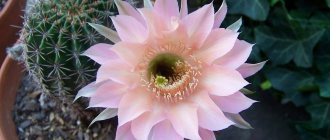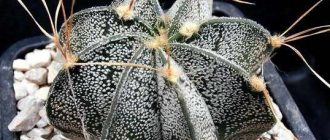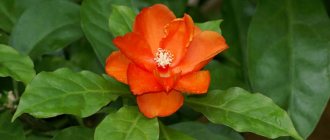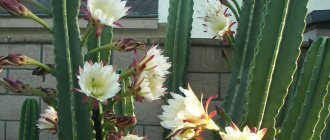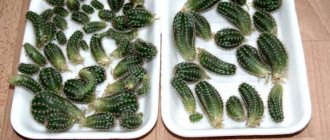Echinopsis is a cactus familiar to us all. In appearance, Echinopsis at an early age resembles a small ball with spines, by the way, this is where its name came from: “echino” - hedgehog, “opsis” - similar. He really looks like a hedgehog curled up in a ball. As the cactus grows, it stretches upward. Some specimens of adult Echinopsis can reach 2 meters in height.
Echinopsis is one of the most beloved and popular types of cacti for indoor floriculture. Growing it is not difficult, even a novice cactus lover can cope with it, and an experienced gardener will not find caring for this plant boring either.
Features of the genus
Translated from Greek, its name means hedgehog .
At the beginning of development, these cacti really look like prickly hedgehogs curled up into a ball. Echinopsis have fleshy stems and a powerful root system. The roots are located close to the surface. Their flowers are very large, located on a long, pubescent stalk. Some have a pleasant aroma.
Different species bloom from early spring to late autumn. Each flower lives in bloom for only a day or two.
The number of flowers on a plant reaches 20-25 pieces . They produce a red or yellowish fruit in the shape of a ribbed barrel or ball.
They grow very quickly, the first flowers appear at the age of 3 years . Varietal varieties grow more slowly.
Transfer
Echinopsis requires regular replanting. Young cactus - annually, adult - once every 24 months. The process is not particularly complicated.
The plant has very strong roots, so you don’t have to worry about damaging them. Experts recommend washing the cactus with hot water as part of the transplant.
Kinds:
- Eyrieza Dark green Echinopsis, spherical in young specimens and short-cylindrical in adult specimens.
Height 20-22 cm, diameter about 15 cm.Areoles are white-yellow, round. The spines are long. The flowers are elongated, white-pink.
- Chilean Tree-like, branches at the base. The stem is cylindrical, elongated. Ribs with pronounced tubercles, low. Pale yellow, one to two centimeters long. The central spine is 4-7 cm . The flowers are large, about 14 centimeters in length.
- Pampana The stem is spherical, 5-7 centimeters in diameter. The spines are curved, up to 5 centimeters long . The flowers are red.
- Shilya
The height of the stem is 5-6 centimeters. About 14 ribs .
The areoles and spines are white. The flowers are fiery red and erect. - Klinger Stem spherical at the top, cylindrical at the base.
The spines are long, grayish, located on light, pubescent areoles. Flowers with multi-tiered petals, snow-white with dark tips. - Dumat The stem is low-growing, rounded, with pronounced ribs. The spines are small. The flowers are lilac-white.
- Sharp-edged , spherical, somewhat elongated stem, diameter 20-25 cm , length 15 cm. Covered with pointed ribs with large areoles. The flowers are lilac-red. Blooms at night, in May-June.
- Mammillosa kermesina Exquisite form of the Echinopsis cactus, single stem, about 30 centimeters . The areoles are round with yellow awl-shaped spines. Pink flowers grow in tiers.
- Tubeflower Green, initially spherical, then cylindrical-shaped stem. The spines are brown, black at the tips. It blooms with large, funnel-shaped, white flowers on a twenty-centimeter stalk.
- Ancistropha Green small stem in the shape of a flattened ball. Covered with pronounced tubercles and hook-shaped spines. The flowers are white.
- Subdenudata
It differs from other species in the absence of spines. A spherical, flattened stem 20 cm high and 10 cm in diameter .
Flowers are 10 cm. Blooms at a young age. - Golden Stem is spherical at the beginning of growth and cylindrical in adults.
Pronounced ribs covered with centimeter-long spines. The flower is yellow-orange. Withstands light frosts. - Backeberg Round-cylindrical stems, height up to 7 centimeters. The flowers are bright pink.
- Bridges Grows in groups of 4 to 6 trunks. Tall, about 40 centimeters , stems with a diameter of 10-13 centimeters. The flowers are white.
- Chamecerus Forms numerous stems hanging over the edge of the pot. Blooms in spring with bright orange flowers. Frost-resistant.
- Bright green Echinopsis Globular stem with a diameter of about 9 centimeters . Sparse radial, numerous central spines.
- Coquimban Cylindrical, elongated stem. In nature it grows up to one meter. Forms dense thickets.
Basic features of Echinopsis
- In a young plant, the stem has a spherical shape, but as the flower grows, the stem can stretch;
- Echinopsis has numerous (from 11-20), clearly defined ribs, on which there are rounded areoles with spines;
- usually there are several thick spines on the areola, reaching a length of 2-3 centimeters;
- Echinopsis blooms in spring, less often in early summer;
- flowers appear on areoles with spines, most often in the upper part of the plant;
- the flowers have a long tube, they themselves are large, can reach 15 cm in width, and are funnel-shaped;
- flowering does not last long, from one to three days;
- The color of the flowers can vary depending on the variety - from white and pink to lilac and violet, there are varieties with yellow and orange flowers.
This article discusses the main types and names of Echinopsis, you will see photos of the most attractive representatives of this species. We will tell you about the basic principles of caring for Echinopsis, how to cause it to bloom, how to propagate and replant your cactus.
Photo
Below are photos of a cactus of the Echinopsis species
Home care
Echinopsis can be freely purchased in the store. When purchasing, inspect it; there should be no signs of rot or pest damage.
After purchase, they are transplanted into a pot, the diameter of which is 1 centimeter larger than the store-bought one . The soil for planting is ready for succulents .
Lighting and temperature
Echinopsis love light, choose the brightest place in the apartment for them. They thrive in direct sunlight. But they need to be accustomed to this gradually to avoid burns.
Growing temperature is from 22 to 27 degrees . In summer, it is advisable to take it out onto the balcony, because there it is possible to reduce the night temperature. The difference between day and night temperatures is favorable for development.
During the autumn cooling, the temperature is gradually increased to 10-12 degrees. Some echinopsis are frost-resistant and can tolerate temperatures down to sub-zero levels.
Humidity and watering
This species tolerates dry air and low humidity.
Watering in summer is plentiful. In autumn, the amount of moisture is gradually reduced, and in November it is stopped. Resume only after a period of rest. In winter they are kept in a cold room; the moisture reserve in the powerful stem lasts until spring.
The frequency of watering and the amount of liquid depends on age. Young small specimens are watered often, adults much less often.
But in any case, the golden rule applies: it is better not to drink too much than to drink too much .
Soil and transplantation rules
This species requires a substrate with a high content of gravel and sand. You can use a store-bought one designed for succulents. You can add humus.
Transplantation is carried out at the end of winter (February) . But not often. Usually this is done through the season, from dry soil to dry soil, and do not water after the procedure for 7-10 days .
There must be drainage in the container. The container for transplantation is taken slightly larger than the previous one.
IMPORTANT . Do not plant echinopsis in a container that is too large and deep - it will not bloom. The pot should be such that there is little space for roots to grow and at the same time cramped.
Top dressing
Echinopsis are fertilized monthly during the growth and flowering period. Use special cactus fertilizer. Make sure that there is no excess nitrogen in the fertilizing, as this can cause the roots to rot.
IMPORTANT . Do not overfeed Echinopsis. It will begin to produce excessive production of children, and there will be no energy left for flowering.
Trimming
Actually, the process of removing babies cannot be called pruning. Excess shoots are simply removed from Echinopsis.
If you allow excessive shoots to form, it will not bloom.
Real pruning is carried out with an elongated corked base. In January, long before the growing season, you need to cut off the brown narrowed part of the stem with a sharp knife and sharpen it slightly.
We place the cut stem on the edge of the pot to dry. We keep it for about seven days, then place it in a bowl of water so that the cut does not reach the surface of the liquid a little.
To do this, use a cardboard stand with a hole in the middle the size of the base of the stem. After a while the roots will appear.
As soon as this happens, we plant the workpiece in the prepared slightly moist soil substrate. Do not rush to water immediately; this can only be done when the sprout takes root.
Maintenance in winter
In winter, cacti have a dormant period. At this time, you need to keep them at a temperature no higher than 10 degrees .
It is a mistake to install Echinopsis in a dark place for the winter.
With a lack of light, it will stretch out and lose its normal shape. If there are no conditions for cold wintering, place it on the windowsill and separate it from the heat with a protective screen.
One way to ensure low temperatures is to use a square aquarium. It is placed on its side, a pot is placed in it and the open side is moved towards the window. This way, your Echinopsis is in the cold, and at the same time has access to light.
During the dormant period, an adult plant is not watered; young, small specimens can be moistened, but no more than twice during the entire period.
Your pet will tell you when to resume watering by the greening of the top of its head.
Reproduction
The easiest way is reproduction by children . They are abundantly overgrown with adult specimens.
The children are separated by unscrewing and placed, slightly buried in the soil.
They take root quickly. Before planting, they are dried for 6-7 days. It is recommended to plant in a mixture of leaf soil and sand. You can add peat to it to improve aeration properties.
The seed method is a chance to get a specimen with brighter colors than the mother one.
The seeds are pre-soaked in warm water. For sowing, take a flat, shallow dish. The first layer is drainage, then a layer of soil. The surface is lightly pressed down, but not too much, to prevent stagnation of moisture.
Distribute the seeds over the surface and sprinkle them with sand. Then moisten with a spray bottle. The crops are covered with glass or film and placed in a damp, dark place until germination. The dishes are regularly aired, but not allowed to dry out.
When seedlings appear, place them in a bright, warm place and grow them as usual. It is advisable to pick when the seedlings reach the size of a large pea.
Brief description of cultivation
- Bloom. In the spring. In some cases, this shrub can bloom for about 6 months.
- Brightness. It needs bright sunlight, so south-facing windows are perfect for Echinopsis.
- Temperature conditions. During the growing season, the room temperature should not be below 20 degrees. In autumn it is recommended to reduce the temperature to 9-10 degrees Celsius, but the light should be as bright as in summer.
- Watering. When the soil is dry to ½ depth, it should be watered regularly. In winter, watering should be very scanty or absent altogether.
- Humidity. It grows normally if the air humidity is the same as in a living room.
- Fertilization. The plant is fertilized from March to September or October; for this purpose, mineral complex fertilizer for succulents and cacti is added to the substrate once every 30 days. During other periods, there is no need to fertilize the plant.
- Rest period. From the second half of autumn to the last days of winter.
- Transfer. When a cactus is young, it needs to be replanted every year, but older plants need to be replanted less often - usually once every 2-3 years. Old and very large shrubs should not be replanted. Replace the top 50mm of soil in the pot with new soil each year.
- Spreading. Through foliage and seeds.
- Pests. Spiders.
- Diseases. Mouth.
Diseases and pests
Echinopsis is almost not susceptible . The main problem is rotting of the roots or base of the stem due to improper watering.
Sometimes inexperienced cactus growers mistake the brown base of the stem for a disease. Don't be afraid.
This is not a disease, but an age-related suberization that is natural for an adult plant. If you don't like this look, you can bury the brown part.
The main pests of Echinopsis are scale insects and spider mites .
The presence of spider mites can be seen by the white coating on the stem. Scale insects appear in the form of brown spots. Washing with soapy water and spraying with fungicides helps combat them.
Mealybugs can also harm Echinopsis. These whitish insects settle on the stems and suck the juices from them. It is removed mechanically with a brush dipped in an alcohol solution. Then they are treated with poison.
Scale insects can also settle in the root system . The plant withers away, does not form shoots and does not bloom .
If you notice this, remove it from the pot. Shake off the soil and wash the roots in a solution of potassium permanganate. Plant in a new pot. Treat the stem with insecticides.
Reproduction
Echinopsis chamecereus is very easy to propagate from cuttings . You need to separate a side shoot from the main stem - it detaches quite easily - and place it in a pot with a diameter of 5-8 cm, filled with the same mixture in which the mother plant is planted. The cutting must be placed horizontally on the soil surface. You can place several cuttings at once in one large tray at a distance of 8–10 cm from each other. If you create the same conditions as for the mother plant, the cuttings will soon begin to grow and, quite possibly, will be ready to flower by next summer.
IN THE PHOTO: During transplantation and other manipulations with the plant, small shoots often break off from the main stem. They do not need to be thrown away, as they can take root at any time of the year. Photo by: @laurenbarnhurst.
Unlike cuttings of most other cacti, cuttings of Echinopsis chamecereus do not need to be dried for several days, but can be planted immediately in a pot.
The attachment points of the side shoots are so small that the risk of rotting at the detachment site is low. Editorial team LePlants.ru
